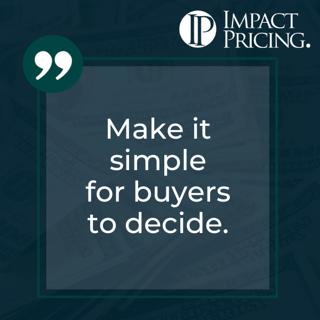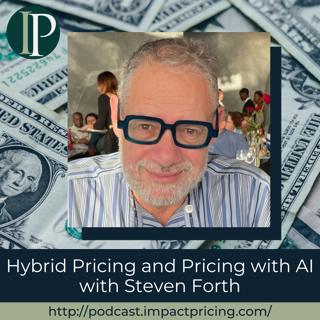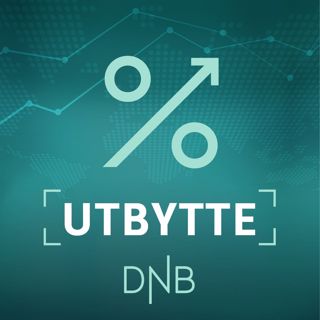
Pricing Table Topics: 6 of Clubs – Have Value Conversation with All Potential Clients
This one is the 6 of Clubs from the Selling Value card deck. First, let's talk about an analytical journey. These are those people who, once they realize they have a problem that they might want to go solve, they spend a bunch of time doing their own research, probably on the internet, figuring out what are the different options, where they might buy it, what are the price points? These are the most price sensitive buyers we can deal with. And yet, if we get an opportunity to talk to them as a salesperson would talk to a potential client, we could be sitting there saying, Hey, here's why our product is better than our competitor's product. But my recommendation would be to make sure we have the value conversation about the inherent value of solving the problem. If we have that conversation, it may be that the buyer didn't realize that there were a lot of other opportunities or a lot of other places where there's value if they buy a product like this. The person might begin to trust the salesperson more and say, Hey, this person's really looking out for my best interest. The buyer is more likely to buy because we're showing them more and more value. So, for a lot of different reasons, it makes sense for us to make sure that we're going back to, let's call it "first principles". We're going back to help our buyers understand what's the value of solving the problem. And in the meantime, we also need to talk about how we are differentiated and possibly better than competitive alternatives. We hope you enjoyed this example of Pricing Table Topics. What you just heard was done without a script. If you want to get better at speaking about pricing and value, grab a deck of our cards, pick a card, read the saying, and then talk for one to two minutes about what that card says. You'll become a better speaker and expert. If you have any questions or feedback, please email me, mark@impactpricing.com. Now, go make an impact. Connect with Mark Stiving: Email: mark@impactpricing.com LinkedIn: https://www.linkedin.com/in/stiving/
3 Mai 20232min

Revolutionize Your Pricing Strategy with 8D Problem-Solving Technique with JD Dillon
JD Dillon is the Chief Marketing Officer, Communications Leader, and Pricing Professional at Tigo Energy. In this episode, JD shares his 8D problem-solving technique that helps create a solid pricing strategy in place. Why you have to check out today’s podcast: Understand what the 8D technique of problem solving is and where you can specifically apply it to Learn how to figure things out and find solutions logically rather than emotionally Discover about the 'Five Why' in verifying the root causes of a problem "If you are in a situation where there's a price reduction, try to do two or three other things first." - JD Dillon Topics Covered: 01:15 - How JD’s Pricing journey started 02:21 - Updates about T.J. Rodgers 03:23 - Overview of what the Eight-D problem-solving technique is all about 04:12 - How does a quality program relate to pricing? 05:32 - What goes on in D-Zero? 07:32 - Where do we ideally apply Eight-D to? [Showing a case study] 08:51 - D-One: What happens here? 10:24 - How do you go about D-Two? 12:36 - Action steps you need to do in D-Three 14:49 - Finding the root causes with D-Four and using the 'Five Why' technique 17:36 - How do you verify permanent corrective action in D-Five? 18:49 - Getting everything executed in D-Six 20:05 - Digging deeper into D-Five and [culture and internal processes] 20:58 - Preventing recurrence in D-Seven 22:48 - D-Eight: Congratulating the team 24:23 - How often do you perform the Eight-D process? 26:55 - JD's best pricing advice 28:25 - Connect with JD Key Takeaways: "Pricing is the quality metric for revenue." - JD Dillon "If you do it right [Eight-D process], it builds into the DNA of the company. And after a few years you've improved your DNA continuously and quite a bit." - JD Dillon "What I described is a thought process, that's all. You can do it in a meeting with people that know what they're doing. I can do it with somebody who's worked for me in the past and we can quickly go through the process in 10 minutes about one small little issue and then move on." - JD Dillon People/Resources Mentioned: Ted Levitt: https://en.wikipedia.org/wiki/Theodore_Levitt T.J. Rodgers: https://en.wikipedia.org/wiki/T._J._Rodgers Connect with JD Dillon: LinkedIn: https://www.linkedin.com/in/jd-dillon/ Connect with Mark Stiving: LinkedIn: https://www.linkedin.com/in/stiving/ Email: mark@impactpricing.com
2 Mai 202329min

Blogcast: Discrimination or Segmentation
This is an Impact Pricing Blog published on March 23, 2023, turned into an audio podcast so you can listen on the go. Read Full Article Here: https://impactpricing.com/blog/discrimination-or-segmentation/ If you have any feedback, definitely send it. You can reach us at mark@impactpricing.com. Now, go make an impact. Connect with Mark Stiving: Email: mark@impactpricing.com LinkedIn: https://www.linkedin.com/in/stiving/
28 Apr 20233min

Pricing Table Topics: 6 of Hearts – Maintain a Comprehensive Value Table
This one is the 6 of Hearts from the Selling Value card deck. I work with clients frequently about creating these value tables. And what we essentially do is we identify, what are the best features in the product? What problem does that feature solve for the client? What's a quantifiable result that client may expect? And then, what's the amount of profit that client may be able to get when they achieve that result? In a way, you could think of this as an ROI calculator. But the problem is, you can't go in with an ROI calculator and tell a buyer, 'Hey, you're going to go make this much money if you buy my product.' They don't believe you. In fact, if you use the document and everything that we put on there, it's probably not accurate for every single customer. In fact, it's probably not accurate for any customer. So, our recommendation is always, when you've created the value table, think of it as a thought process, this is where the value could be. And now we go talk to a buyer. And we understand, do you have this problem? 'Oh, yeah.' What kind of result do you think you might expect? 'Oh, let's see if we can figure out the profit to your company if you achieve that result.' We use this as a map, as a document to help us understand where we're going, but we don't use the document to say these are the facts for any given client. So, we want to use the information, not the details of the document. We hope you enjoyed this example of Pricing Table Topics. What you just heard was done without a script. If you want to get better at speaking about pricing and value, grab a deck of our cards, pick a card, read the saying, then talk for one to two minutes about what that card says. You'll become a better speaker and expert. If you have any questions or feedback, please email me, mark@impactpricing.com. Now, go make an impact. Connect with Mark Stiving: Email: mark@impactpricing.com LinkedIn: https://www.linkedin.com/in/stiving/
26 Apr 20232min

How Subscription Business Model is Revolutionizing Pricing with Joe Woodard
As the founder and CEO, Joe Woodard empowers small business advisors to transform small businesses. He works toward this vision as the host of the annual Scaling New Heights conference, the host of Woodard Alliance, the head of Woodard Institute and various speaking and writing engagements he performs throughout the accounting and bookkeeping professions. In this episode, Joe discusses how to design a subscription pricing model that prioritizes building strong relationships with clients, empowering them, and generating a long-term impact on their businesses. This approach also helps increase the lifetime value of clients. Why you have to check out today’s podcast: Get an in-depth discussion on pricing result versus pricing transaction Understand how charging relationships works in a subscription pricing model Uncover how to price human connections that go beyond financial reasons "Be bold with pricing. You are worth more than you think you are, and definitely more than your clients think you are." - Joe Woodard Topics Covered: 01:29 - Talks about getting differentiated from the rest with his degree in classical Greek 03:37 - How his career path ended in Pricing 04:25 - What is so significant about the subscription business model? 06:16 - How do you price a relationship? 10:08 - Going in-depth into pricing for a relationship 13:40 - Measuring the service-provider-client relationship 15:12 - Going beyond financial outcomes when measuring the economics of relationship 16:25 - Discussions around Mark's objections: 'I don't see how you price for it [relationship] 17:02 - Pricing human connection that transcends economics 20:57 - The danger about price segmentation in relation to pricing relationship 22:03 - Pricing segmentation's end-goal in a subscription model 23:38 - Healthy subscription versus toxic subscription 25:48 - Driving customer lifetime value plus creating experiences for engagement 27:43 - Joe’s pricing advice 29:19 - Connect with Joe Key Takeaways: “We're intensely focused on the customer's outcome, and our outcomes become a means to that outcome. And therefore, we are pricing the relationship we have with the client because it's about the outcomes we're driving in that relationship.” - Joe Woodard “I am delivering, within the context of a relationship, value. And part of that is, I’m giving you attention at the individual level. Not a newsletter, not cookie cutter answers. There's something where you're individually being touched.” - Joe Woodard “Relationship economics is about the business outcomes or the business benefits that are gained by being in a relationship.” - Joe Woodard “The intensity of the relationships increases based on the value that you've added in the amount of attention that you're able to give.” - Joe Woodard People / Resources Mentioned: Ron Baker: https://impactpricing.com/podcast/ep44-ronald-j-baker-trash-the-timesheet-exploring-opportunities-in-subscription-businesses/ Connect with Joe Woodard: LinkedIn: https://www.linkedin.com/in/quickbooksadvisor/ Website: https://www.woodard.com/ Connect with Mark Stiving: LinkedIn: https://www.linkedin.com/in/stiving/ Email: mailto:mark@impactpricing.com
24 Apr 202330min

Blogcast: Interesting Starlink Price Changes
This is an Impact Pricing Blog published on March 16, 2023, turned into an audio podcast so you can listen on the go. Read Full Article Here: https://impactpricing.com/blog/interesting-starlink-price-changes/ If you have any feedback, definitely send it. You can reach us at mark@impactpricing.com. Now, go make an impact. Connect with Mark Stiving: Email: mark@impactpricing.com LinkedIn: https://www.linkedin.com/in/stiving/
21 Apr 20234min

Pricing Table Topics: 6 of Spades – Make It Simple for Buyers to Decide
This one is the 6 of Spades from the Selling Value card deck. Make it simple for buyers to decide. One of my favorite sayings is, “A confused buyer won't buy.” If you think about it, we're all afraid to make mistakes. We don't want to make mistakes. And the more difficult we make the decision, the more likely somebody thinks, a buyer thinks, they might make a mistake. We want to make the decision really simple, really clear, really obvious, so that our buyers don't think they're making a mistake. There are two techniques that are really common in simplifying this decision process. One is Good-Better-Best. If you have a complex price list, a complex set of options, buyers get confused. They really don't want to make that decision. They don't want to make a mistake. But if you can simplify the decision into a good-better-best offering, it's so much easier for buyers to make that decision, and they're so much more likely to make it. Another place we often see the simple decision for buyers is called The Decoy Effect. This is a psychological aspect in pricing. But a decoy effect is essentially good-better-best, but it's where you make the better price and the best price really, really close to each other. And so, buyers look at that and it's easy to make a decision between best and better because it's a slight, or maybe even no price increase, and they get a lot more. And so, yeah, I can choose best over better. And once they know they can make an easy decision, they feel like they're not going to make a mistake. So the rule here, make it simple for buyers to decide. We hope you enjoyed this example of Pricing Table Topics. What you just heard was done without a script. If you want to get better at speaking about pricing and value, grab a deck of our cards, pick a card, read the saying, and then talk for one to two minutes about what that card says. You'll become a better speaker and expert. If you have any questions or feedback, please email me, mark@impactpricing.com. Now, go make an impact. Connect with Mark Stiving: Email: mark@impactpricing.com LinkedIn: https://www.linkedin.com/in/stiving/
19 Apr 20232min

Hybrid Pricing and Pricing with AI with Steven Forth
Steven Forth is Ibbaka’s Co-Founder, CEO, and Partner. Ibbaka is a strategic pricing advisory firm. He was CEO of LeveragePoint Innovations Inc., a SaaS business designed to help companies create and capture value. Steven is what I consider one of the great pricing thinkers in our industry. In this episode, Steven enlightens us about hybrid pricing models and explains why we should adopt it. He also shares why pricing people need to change the way they see AI along with the work they do in pricing. Why you have to check out today’s podcast: Understand one of the unstated rules of pricing that talks about pricing power along with insights into future risk Find out how artificial intelligence (AI) can help address concerns regarding the connection between pricing and predictability, and why pricing people should change how they see AI in line with pricing Discover the reason on why most of us need to adopt hybrid pricing models and why the two pricing metrics in that should be independent of each other “Most of us need to adopt hybrid pricing models, and the two pricing metrics should be independent of each other. If the two pricing metrics track each other closely, why bother having a hybrid pricing model? You need two metrics that are relatively independent of each other, and that will give you the flexibility you need to respond in a difficult economic environment.” – Steven Forth Topics Covered: 00:42 – Steven’s insights on what a hybrid pricing model looks like 02:30 – Issues on pricing model that applies credits/tokens to usage 04:44 – Predictability; whoever has the best insight into future risk has the greatest pricing power 09:37 – Pricing people vs. the recent trend: AI and how it sets prices 12:02 – The Achilles heel of value-based pricing, and the hybrid pricing practice in companies 18:09 – What real value-based pricing is about 20:52 – An optimal pricing model if you want to combine two metrics 24:31 – Confused buyers don’t buy and renew 27:18 – Three reasons why calculators don’t expose their logic 28:42 – Steven’s pricing advice 29:42 – Connect with Steven Key Takeaways: “If you have enough data, you can actually get pretty good at predicting future usage.” – Steven Forth “One of the unstated rules of pricing is that whoever has the best insight into future risk has the greatest pricing power. The better we get at prediction, the more accurate we can get at pricing, and the question then becomes, who has the data to make those predictions? And I think in many cases, it's actually the vendor who has better access to data.” – Steven Forth “This whole question of predictability and pricing is going to be a key question for pricing over the next three to five years, and the artificial intelligences are going to help us to answer that question much better than we've ever been able to answer it before.” – Steven Forth “If you're optimizing value for the customer, you're optimizing the amount that they're willing to pay you, so if you just do it to optimize revenue, you'll end up shooting yourself in the foot because you'll trigger that negative feedback loop.” – Steven Forth Connect with Steven Forth: Email: steven@ibbaka.com LinkedIn: https://www.linkedin.com/in/stevenforth/ Connect with Mark Stiving: LinkedIn: https://www.linkedin.com/in/stiving/ Email: mark@impactpricing.com
17 Apr 202328min





















